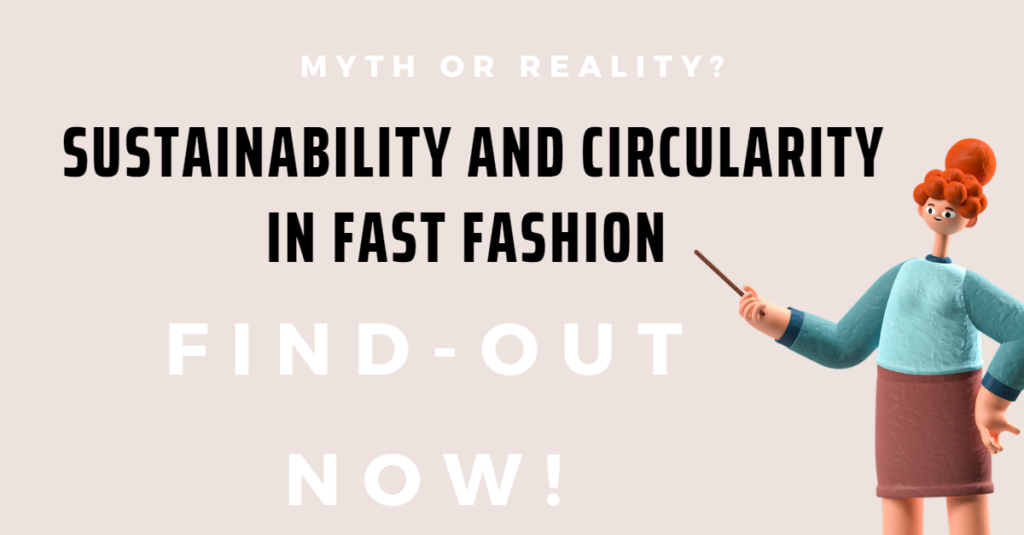Sustainability And Circularity In Fast Fashion – Myth Or Reality?
Fast fashion has become a buzzword in the fashion industry over the past few decades. It refers to the rapid production and consumption of inexpensive clothing, often modeled after the latest fashion trends. While fast fashion has made fashion more affordable and accessible, it has also raised concerns about its impact on the environment and society. In recent years, the fashion industry has been exploring sustainable and circular practices to address these concerns. But are sustainability and circularity in fast fashion just myths or realities? Let’s take a closer look.
Sustainability in Fast Fashion
Sustainability refers to the ability to meet the needs of the present without compromising the ability of future generations to meet their own needs. In the context of the fast fashion industry, sustainability means reducing the environmental impact of the production, consumption, and disposal of clothing.
Many fast fashion brands have recognized the need for sustainability and have made efforts to reduce their impact on the environment. One way they do this is by using sustainable materials, such as organic cotton, recycled polyester, and Tencel. These materials are better for the environment because they use fewer resources, emit fewer greenhouse gases, and generate less waste.
In addition to using sustainable materials, some fast fashion brands have implemented sustainable practices in their production processes. For example, some brands have introduced water-saving technologies in their factories, which reduce the amount of water used in the production of clothing. Others have implemented closed-loop systems, which recycle fabric scraps and waste into new clothing.
However, it is important to note that sustainability in fast fashion is still a work in progress. While many brands have made efforts to reduce their environmental impact, the industry as a whole still has a long way to go. For example, the production of clothing still generates a significant amount of greenhouse gas emissions, and the disposal of clothing often involves sending it to landfills, where it can take hundreds of years to decompose.
Circularity in Fast Fashion
Circularity refers to the idea that resources should be kept in use for as long as possible, and that waste should be eliminated. In the context of the fast fashion industry, circularity means reducing the amount of clothing that is thrown away, and increasing the amount that is reused, recycled, or repurposed.
Many fast fashion brands have implemented circular practices in their business models. For example, some brands have introduced clothing rental services, which allow customers to rent clothing instead of buying it. This reduces the amount of clothing that is produced, and also reduces the amount of clothing that is thrown away after it has been worn a few times.
Other brands have introduced take-back programs, which allow customers to return their old clothing to the brand for recycling or repurposing. This reduces the amount of clothing that is sent to landfills, and also creates a new supply of raw materials for the production of new clothing.
However, as with sustainability, circularity in fast fashion is still a work in progress. While some brands have implemented circular practices, the industry as a whole still has a long way to go. For example, the vast majority of clothing is still disposed of in landfills, and many fast fashion brands still rely on a business model that encourages customers to buy new clothing frequently.
Myth or Reality?
So, is sustainability and circularity in fast fashion a myth or a reality? The answer is complicated.
On the one hand, many fast fashion brands have made significant efforts to reduce their environmental impact and implement circular practices. These efforts are commendable and should be celebrated. However, on the other hand, the fast fashion industry as a whole still has a long way to go before it can be considered truly sustainable and circular.
One of the biggest challenges facing the fast fashion industry is the sheer volume of clothing that is produced and consumed. According to the Ellen MacArthur Foundation, the equivalent of one garbage truck full of textiles is landfilled or burned every second. This is a staggering amount of waste, and it is clear that the fast fashion industry needs to do more to reduce the amount of clothing that is produced and consumed.
Another challenge is the affordability of sustainable and circular fashion. While sustainable and circular fashion can be more expensive to produce, it is important to make these practices accessible to all consumers, regardless of their income level. This requires a shift in the fast fashion business model, which currently relies on a constant cycle of new clothing production and consumption.
Furthermore, while some fast fashion brands have implemented sustainable and circular practices, many others have not. This creates a confusing landscape for consumers, who may not know which brands to trust and which ones to avoid. It is important for the fast fashion industry as a whole to embrace sustainability and circularity, and for consumers to demand it from the brands they support.
Finally, there is a need for greater transparency in the fast fashion industry. Consumers need to know where their clothing comes from, how it was made, and what impact it has on the environment. This requires greater accountability from fast fashion brands, as well as greater access to information for consumers.
Conclusion
In conclusion, sustainability and circularity in fast fashion are both a myth and a reality. While many fast fashion brands have made efforts to reduce their environmental impact and implement circular practices, the industry as a whole still has a long way to go. The sheer volume of clothing that is produced and consumed, the affordability of sustainable and circular fashion, the lack of consistency among fast fashion brands, and the need for greater transparency all present challenges that must be addressed.
Ultimately, the responsibility for sustainability and circularity in fast fashion falls on all of us – consumers, brands, and policymakers alike. Consumers can demand more sustainable and circular practices from the brands they support, while brands can work to shift their business models and become more transparent about their practices. Policymakers can introduce regulations that incentivize sustainable and circular practices, and penalize those that do not comply.
It is clear that the fast fashion industry needs to change if it is to become truly sustainable and circular. However, with greater awareness, accountability, and collaboration, it is possible to create a fashion industry that is both fashionable and sustainable, and that benefits both people and the planet.

My name is Rohit Vagh and I’m a content writer specializing in fashion and lifestyle. I have three years of experience in this field and have written various articles. My writing style is creative and engaging, and I strive to create content that resonates with my readers. I have a deep passion for fashion and am constantly researching the latest trends and styles to make sure my readers are up to date. I’m excited to continue my career in blogging, and I’m always looking for new opportunities in the fashion and lifestyle space.





